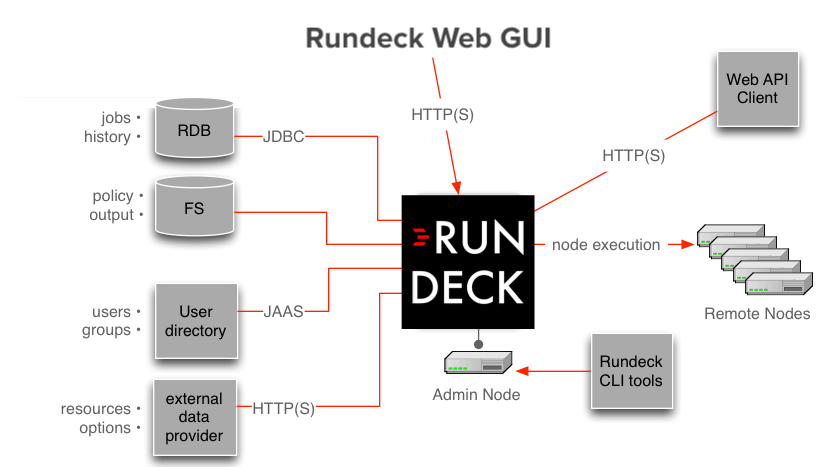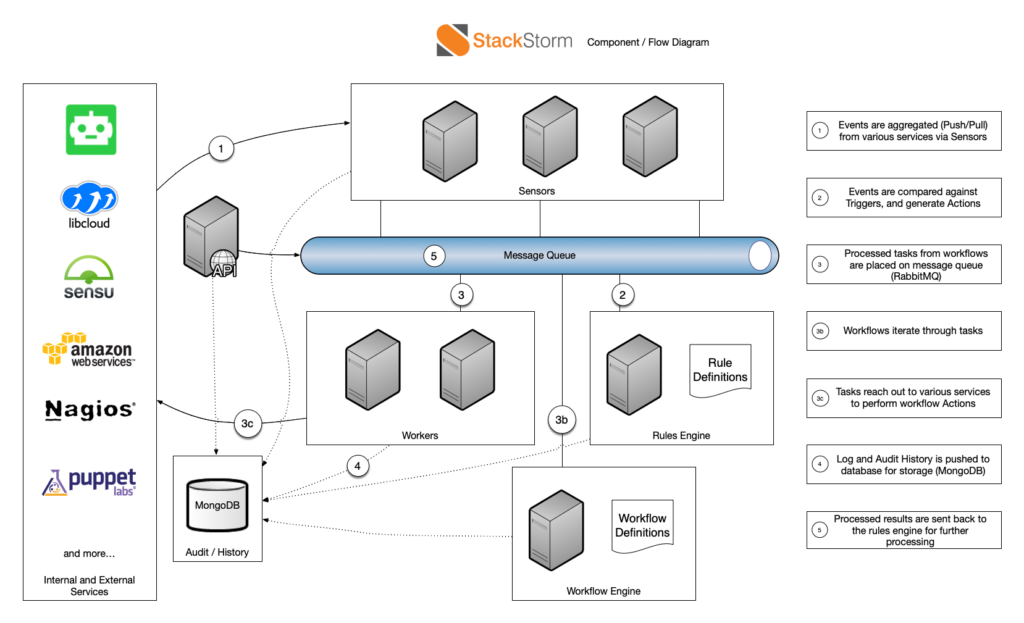Automation platforms like Rundeck and StackStorm have transformed IT operations by reducing manual effort, eliminating human error, and streamlining workflows. These platforms are essential for businesses aiming to improve operational efficiency and reduce downtime. In this blog, we compare Rundeck vs StackStorm, exploring their features, use cases, and how to choose the right tool for your automation needs.
Listen to the audio version, crafted with Gemini 2.0.
Rundeck
Overview: Why Rundeck?
Rundeck, an open-source automation platform released in 2010, simplifies IT tasks like job scheduling and credential management. Popular among system administrators and DevOps teams, it is known for its user-friendly design and robust functionality.
Key Features of Rundeck
- Job Scheduling
- Supports cron-like syntax for detailed scheduling.
- Calendar-based integration for flexible task planning.
- Handles ad-hoc jobs for on-demand tasks.
- Workflow Automation
- Includes a graphical workflow editor.
- Supports parallel and sequential task execution.
- Credential Management
- Securely stores sensitive credentials like API keys.
- Implements role-based access for secure operations.
- Plugin Ecosystem
- Integrates with popular tools like Ansible and Kubernetes.
- Extensible through a rich library of plugins.

Use Cases for Rundeck
- Server Provisioning and Configuration: Automate server deployment and configurations.
- System Maintenance: Handle patching, backups, and system health checks.
- Software Deployments: Roll out applications across multiple environments efficiently.
Benefits of Rundeck
- Ease of Use: Intuitive UI simplifies automation.
- Scalability: Handles large workloads across distributed environments.
- Security: Advanced credential management protects sensitive data.
- Community Support: Active forums and detailed documentation.
StackStorm
Overview: Why StackStorm?
StackStorm, released in 2014, is a cutting-edge, event-driven automation platform. It’s ideal for dynamic environments that require real-time responses and complex multi-system workflows.

Key Features of StackStorm
- Event-Driven Automation
- Automates tasks based on triggers and events.
- Responds dynamically using sensors, rules, and actions.
- Workflow Orchestration
- Manages complex, multi-step workflows.
- Connects diverse systems into cohesive pipelines.
- Integrations
- Extensive pre-built integrations with AWS, Slack, and Docker.
- Customizable with plugins for unique needs.
- Self-Service Automation
- Provides portals for non-technical users to initiate automations.
- Reduces dependency on IT teams for routine tasks.
Use Cases for StackStorm
- Incident Response: Automate remediation for security alerts and system failures.
- Cloud Orchestration: Streamline provisioning and management of cloud resources.
- CI/CD Pipelines: Automate builds, tests, and deployments.
- ChatOps: Execute automations through platforms like Slack.
Benefits of StackStorm
- Flexibility: Handles complex workflows across diverse systems.
- Scalability: Adapts to the demands of large-scale environments.
- Extensive Integrations: Connects with a wide range of tools and platforms.
- Proactive Automation: Event-driven approach ensures real-time responses.
Comparison: Rundeck vs StackStorm
| Feature | Rundeck | StackStorm |
|---|---|---|
| Scheduling | Yes | Yes |
| Workflow Automation | Yes (graphical) | Yes (graphical) |
| Credential Management | Yes | Yes |
| Integrations | Limited | Extensive |
| Event-Driven Automation | No | Yes |
| Self-Service Automation | No | Yes |
| Ease of Installation | Easy (standalone, Docker) | Moderate (multi-component) |
| Learning Curve | Low | Moderate |
Scalability and Performance
- Rundeck: Ideal for scheduled, predictable tasks in distributed setups.
- StackStorm: Excels in dynamic, event-driven environments with high scalability.
Decision Matrix
| Criteria | Best Choice |
|---|---|
| Simple job scheduling | Rundeck |
| Event-driven automation | StackStorm |
| Extensive tool integrations | StackStorm |
| Ease of setup | Rundeck |
| Building self-service automation | StackStorm |
| Managing routine IT tasks | Rundeck |
| Budget | Both (Open-source) |
Conclusion
When comparing Rundeck vs StackStorm, both platforms offer unique strengths. Rundeck’s simplicity and reliability make it ideal for routine IT tasks, while StackStorm’s flexibility and event-driven architecture are better suited for complex workflows.
For businesses with diverse needs, combining Rundeck and StackStorm can provide comprehensive automation coverage. Rundeck can handle routine tasks, while StackStorm excels in orchestrating dynamic workflows. To explore further, visit their official documentation: Rundeck | StackStorm.
Automation is the key to operational excellence. Choose the platform that aligns with your goals and empowers your team to thrive.
Explore More
- AI Services: Explore our AI services for more details.
- Digital Product Development: Discover our digital product development expertise.
- Design Innovation: Learn about our design innovation approach.





Leave a Reply